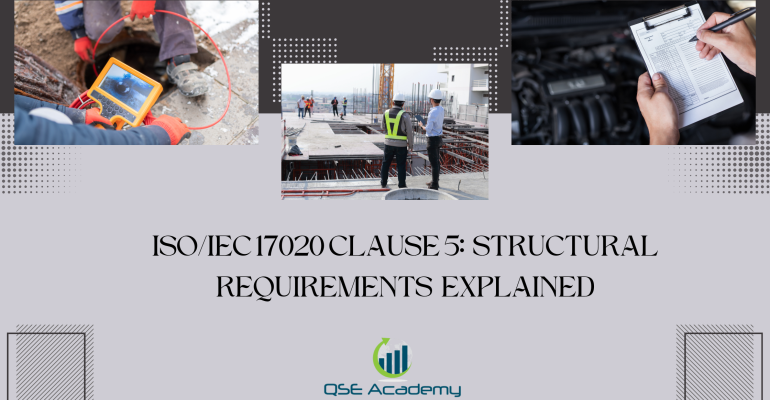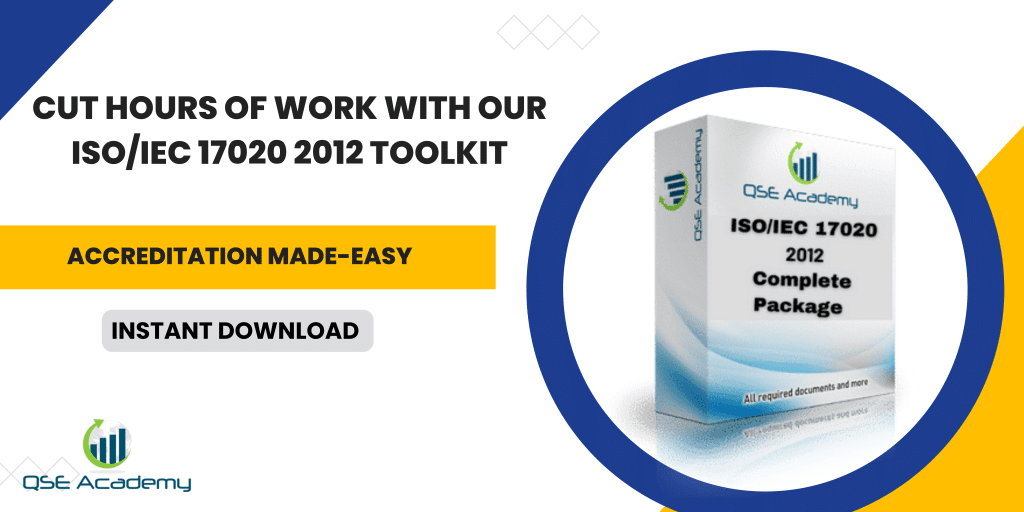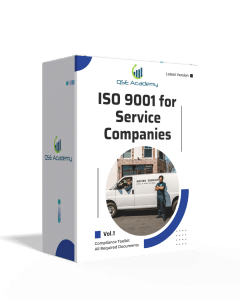ISO/IEC 17020 Clause 5: Structural Requirements Explained
Last Updated on October 22, 2025 by Hafsa J.
How Structure Shapes Compliance in ISO/IEC 17020
Every time I help a new inspection body prepare for accreditation, one issue comes up early—structure. Not the physical kind, but the organizational kind. Clause 5 of ISO/IEC 17020 is all about who’s responsible, who reports to whom, and how those relationships protect impartiality.
Here’s what I’ve noticed: small and medium inspection bodies often underestimate this clause. They assume an org chart is enough. But Clause 5 isn’t just about drawing boxes and arrows. It’s about proving that your inspection decisions are made independently, your authority lines are clear, and no one outside the process can influence results.
If your structure isn’t documented—or worse, if it’s inconsistent across departments—you’re inviting non-conformities.
This section will walk you through how to design a structure that makes sense, passes audits, and supports impartiality every step of the way. You’ll learn how to define authority, maintain control across branches, and show auditors that your organization operates like a well-tuned system—not a collection of titles.
What Clause 5 Really Means – The Foundation of Accountability
Clause 5 is simple on the surface: your inspection body must have a defined structure that supports impartiality and consistent operations. But in practice, it’s the backbone of your entire management system.
Here’s how I explain it to clients—Clause 5 is about clarity. Everyone in your organization should know exactly who’s responsible for decisions, who approves inspection results, and who ensures compliance. When those lines blur, so does accountability.
I’ve seen inspection bodies lose credibility because two managers assumed the other was handling impartiality reviews, or because inspection reports were signed off by someone with no defined authority. Those small oversights create big audit problems.
Pro Tip: Start by mapping your process before you map your structure. If you know how inspections flow—from client request to final report—you’ll see where authority needs to be assigned and documented.
A common mistake? Thinking hierarchy equals compliance. You don’t need a tall structure—you need a clear one. Even small inspection bodies can meet Clause 5 if roles and responsibilities are well defined.
Now that we’ve unpacked the intent behind Clause 5, let’s look at how to actually define those roles, responsibilities, and authority so your system stands strong under audit.
Defining Roles, Responsibilities, and Authority
This is where Clause 5 starts getting practical. It’s not enough to say your organization is “well-structured.” You need to show exactly who’s responsible for what — and that everyone has the authority to do their job without interference.
Here’s what I’ve noticed over years of working with inspection bodies: confusion doesn’t come from lack of people, it comes from lack of clarity. When roles overlap or no one knows who makes the final decision, impartiality and efficiency both suffer.
Start with these essential positions:
-
Top Management / Director – ultimately accountable for impartiality, resources, and compliance.
-
Quality Manager – ensures the management system is implemented, maintained, and improved.
-
Technical Manager – oversees inspection activities, competence, and technical validity.
-
Inspectors / Support Staff – perform inspections, collect evidence, and report results objectively.
Each role should have a written description that defines both responsibility and authority. That means: who reports to whom, who approves inspection reports, and who signs off on corrective actions.
Pro Tip: Create a Responsibility Matrix (often called an RACI chart) that maps tasks against roles — Responsible, Accountable, Consulted, and Informed. It’s simple, visual, and instantly clears up confusion during audits.
Common mistake? Letting the Quality Manager also be responsible for approving inspection results. That blends management and inspection decisions — and auditors flag it fast.
Now that your roles are defined, the next step is ensuring those reporting lines protect independence and don’t compromise impartiality.
Managing Organizational Independence and Reporting Lines
You can have the most detailed org chart in the world—but if your reporting lines blur independence, you’ll run into trouble fast. Clause 5 connects directly to Clause 4 on impartiality, because how your people report defines how objective your inspections can be.
Here’s the reality: independence isn’t just about avoiding conflicts of interest. It’s about building structural safeguards so no one can influence inspection outcomes, even unintentionally.
For example, if your inspection manager reports to a commercial director, that’s an immediate red flag. The commercial side is naturally driven by business goals—sales, client satisfaction, contracts. The inspection side must be driven by evidence, standards, and objectivity. Those goals often conflict, and that’s exactly what Clause 5 is meant to prevent.
Pro Tip: Use functional rather than hierarchical reporting for technical decisions. In other words, inspectors can report administratively to HR or management for logistics—but technically, they should answer to the technical or quality manager for inspection outcomes.
Some inspection bodies add dotted-line reporting to clarify advisory or oversight roles. It’s a small detail, but it tells auditors you’ve thought carefully about independence.
A common mistake? Overcomplicating reporting lines in small teams. Independence doesn’t require a big structure—it requires a clear one. As long as responsibilities are separated and documented, even a three-person inspection body can fully comply.
Now that we’ve nailed down independence and reporting, let’s move to another critical area—how to maintain control when you operate across multiple sites or use subcontractors.
Control of Branch Offices, Sites, and Subcontractors
If your inspection body operates more than one location—or relies on subcontractors—Clause 5 expects you to prove that control doesn’t weaken as you expand. Every site, every person, and every subcontracted inspection must operate under the same management system. No exceptions.
Here’s what often happens: a main office runs perfectly, but remote sites do things “their own way.” Maybe they use outdated forms or skip impartiality reviews because “the client needed it fast.” During an audit, that inconsistency immediately shows up—and it’s one of the most common findings under Clause 5.
Here’s how to stay compliant and in control:
-
Document control mechanisms. Define how headquarters monitors all sites and subcontractors. Include reporting frequency, audit schedules, and communication channels.
-
Apply the same procedures everywhere. Whether it’s calibration, record keeping, or inspection review—each branch must follow the same approved versions.
-
Evaluate subcontractors thoroughly. Verify their competence, impartiality, and documentation practices before assigning any work.
-
Keep records of oversight. Minutes from coordination meetings or performance reviews serve as evidence of centralized control.
Pro Tip: Conduct internal audits across all branches at least annually. If you use subcontractors, treat them like extensions of your own system—audit them too.
Common mistake? Assuming subcontractors automatically comply because they’re “experienced.” Auditors will expect proof that you evaluated and approved them.
Now that we’ve covered structural control, let’s move into another critical part of Clause 5—making sure management provides the resources and support your structure needs to actually function.
Ensuring Resources and Management Support
A strong structure means nothing if management doesn’t back it up with resources. Clause 5 makes it clear: top management isn’t just responsible for setting up the organization—they must support it with enough people, equipment, and time to work effectively.
I’ve seen too many inspection bodies where one person wears five hats—technical manager, quality manager, inspector, and admin—because “we’re still small.” It’s understandable, but when roles overlap too much, impartiality and consistency suffer.
Here’s what works:
-
Assess workload and capacity regularly. Make sure inspections, document reviews, and internal audits are achievable with your current staff.
-
Plan for competence and backup. Every key role—especially technical and quality managers—should have a trained substitute to avoid system breakdowns when someone’s away.
-
Provide the right tools. That includes calibrated equipment, software for report management, and access to standards and reference materials.
-
Document resource decisions. Record discussions about staffing, training, and equipment in management review minutes—it’s solid audit evidence of top management commitment.
Pro Tip: Don’t treat resources as “budget talk.” Treat them as risk control. Under-resourcing is one of the fastest ways to create errors and nonconformities.
A client once told me, “We thought our process was failing, but it was just a capacity issue.” After adjusting workload and adding one part-time inspector, their audit findings disappeared.
Once your structure is supported by the right resources, the next step is ensuring it integrates smoothly with your quality management system (QMS)—so every role, process, and document aligns.
Integration With the Quality Management System
Clause 5 doesn’t exist in isolation—it’s the backbone that holds your entire quality management system (QMS) together. Think of it this way: your structure defines who is responsible, and the QMS defines how they do it. When those two don’t align, confusion and nonconformities follow fast.
Here’s what I’ve seen in real audits: organizations have beautifully written procedures, but their org charts or job descriptions don’t match those documents. For instance, a procedure says “the Technical Manager approves inspection reports,” but the org chart shows that role reporting to the Commercial Manager. That disconnect instantly signals weak control.
Here’s how to make your structure and QMS work as one:
-
Cross-check documents. Ensure every role mentioned in procedures also appears in your org chart and job descriptions.
-
Synchronize updates. When someone changes position, or when reporting lines shift, update all related documents at the same time.
-
Include structural checks in internal audits. Auditors should verify that authority and responsibilities described in your QMS are accurate and up-to-date.
-
Keep management reviews linked. Discuss structural changes and resource allocation alongside quality performance—it shows integrated control.
Pro Tip: Treat your structure like a “living document.” Each time your QMS evolves, review whether roles and authority still make sense.
A well-integrated structure doesn’t just pass audits—it builds confidence. Staff know who to go to, auditors see consistency, and clients trust your reliability.
Now that we’ve covered the key elements of Clause 5, let’s wrap up with a few frequently asked questions inspection bodies often raise about structural requirements.
FAQs – Structural Requirements in ISO/IEC 17020
Q1. Do small inspection bodies need a full management team?
Not necessarily. ISO/IEC 17020 doesn’t require a big team—it requires defined roles. If one person handles multiple responsibilities, that’s fine, as long as impartiality is protected and authority is clearly documented. Auditors care about clarity, not headcount.
Q2. How often should we review our organizational chart and responsibilities?
At least once a year—or sooner if there’s any structural change. For example, new staff, new services, or new reporting lines should trigger an immediate review. Outdated org charts are a common and unnecessary audit finding.
Q3. Can subcontractors be part of our structure?
Not directly, but they fall under your control. You’re responsible for ensuring subcontractors operate under your management system. That means verified competence, clear communication, and documented oversight.
Pro Tip: Keep a subcontractor control file with evaluation records, contracts, and performance reviews. Auditors love seeing that level of traceability.
These FAQs might seem basic, but they’re the same issues that cause most structural nonconformities. Keeping them in check means your system stays strong, consistent, and defensible under audit.
Now let’s close this out by tying it all together—why your structure isn’t just a compliance formality, but a confidence-building framework.
Building a Structure That Supports Confidence
Clause 5 isn’t about adding layers of management—it’s about creating clarity and control. A well-structured inspection body gives everyone confidence: your team knows who’s accountable, your clients trust your objectivity, and auditors see stability behind every inspection report.
Over the years, I’ve seen inspection bodies transform their systems simply by redrawing their structure and defining roles properly. The difference is always immediate—less confusion, faster decision-making, and zero findings about “unclear responsibilities.”
Here’s the truth: a clear structure isn’t bureaucracy; it’s efficiency. It ensures impartiality (Clause 4), supports resources (Clause 6), and ties directly into your QMS (Clause 8). When your structure is documented, aligned, and understood, compliance becomes effortless.
Pro Tip: Review your organizational setup before every surveillance audit. Ask yourself: “Are responsibilities still accurate? Are reporting lines still protecting impartiality?” That simple check keeps your system audit-ready all year.
If you’re unsure whether your structure meets ISO/IEC 17020 expectations, QSE Academy can help. Download our ISO/IEC 17020 Organizational Structure Template or schedule a quick review call to fine-tune your system before your next assessment.
I hold a Master’s degree in Quality Management, and I’ve built my career specializing in the ISO/IEC 17000 series standards, including ISO/IEC 17025, ISO 15189, ISO/IEC 17020, and ISO/IEC 17065. My background includes hands-on experience in accreditation preparation, documentation development, and internal auditing for laboratories and certification bodies. I’ve worked closely with teams in testing, calibration, inspection, and medical laboratories, helping them achieve and maintain compliance with international accreditation requirements. I’ve also received professional training in internal audits for ISO/IEC 17025 and ISO 15189, with practical involvement in managing nonconformities, improving quality systems, and aligning operations with standard requirements. At QSE Academy, I contribute technical content that turns complex accreditation standards into practical, step-by-step guidance for labs and assessors around the world. I’m passionate about supporting quality-driven organizations and making the path to accreditation clear, structured, and achievable.











